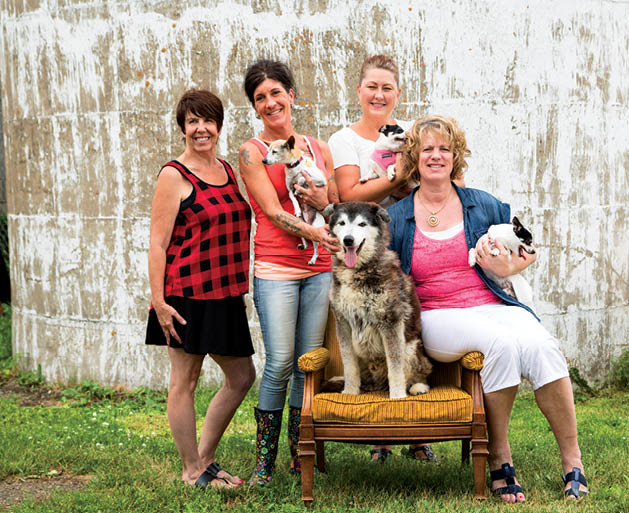Scenario: The stress or monotony of everyday life has gotten to you. Maybe the kids recently moved on to college. Or, sadly, you might recently have lost a pet. Regardless the cause, the St. Croix Valley has numerous pet services available, whether you want to volunteer or adopt your own.
A brief history: Coco’s Heart Dog Rescue is an effort grounded in love, dedication and determination. The dream of establishing this rescue started back in 2000, when a very special dog, Coco, passed away unexpectedly at age 5. The loss inspired Coco’s owner, 12-year-old Ashley Van Ort, to save other canine friends in his name. Today Coco’s Heart Dog Rescue is a foster-based, volunteer-driven rescue and has found loving homes for about 3,000 animals since May 2010.
A noble mission: Coco’s Heart Dog Rescue’s volunteers rescue animals from unfortunate situations and houses them in foster homes while preparing them for adoption placement. “We focus on evaluating each dog’s needs, provide high-quality veterinary care and work towards finding them a lifelong match with an adoption placement,” founder Ashley (Van Ort) Kurtz says. “We strive to educate our community on the importance of rescue.”
Identifiable services: Rescue and adoption placement: “We also have a Senior Buddies Outreach Program (select adoptable dogs and volunteers visit nursing home residences monthly) and our Coco’s Heart Academy (educating others on our efforts),” Kurtz says.
Number of animals (in-house and/or fostered): Coco’s Heart has upwards of 200 in rescue.
Kinds/breeds of animals: “We are an all-breed dog rescue,” Kurtz says.
Specialties that set apart: While Kurtz herself wouldn’t admit it, it’s her very personal story that sets Coco’s Heart apart. “We strive to make lifelong matches and really take the extra time to try to find our dogs the best fits,” she says.
Committed staff: With two full-time and two part-time staff members, “We do have 800-plus volunteers and average 140 active foster homes,” Kurtz says.
How to get involved or adopt: Check out cocosheartdogrescue.org to learn more.
Average cost/adoption: $500.
A brief history: In 2005, Karen Zacharias and a small group of like-minded friends started a foster-based adoption program with the help of Brian Kersten at Baldwin Veterinary Center in Baldwin, Wis. Kersten volunteered kennel space at his clinic until a proper foster home could be arranged for area strays. The fast-growing group, PAWS of Wisconsin, has now adopted out more than 1,400 animals.
A noble mission: To protect animals from cruelty, neglect, homelessness and indifference.
Identifiable services: “We started out as a spay/neuter organization, providing funding for low-income people to be able to spay/neuter their pets,” says Zacharias, who now serves as treasurer of PAWS. “We then branched into spaying/neutering farm and feral animals, as funding was available.”
Number of animals: Being a foster-only service means a smaller number of pets stay at approved volunteer foster homes in the area. The number varies based on those caring individuals willing and able to house a pet for a limited amount of time, until a forever-home can be identified. Currently there are 12 such fosters in the area.
Kinds/breeds of animals: “We are not breed-specific,” Zacharias says. “Most of our animals are strays, so we get a lot of mixed breeds.”
Specialties that set apart: One of the benefits of a 100 percent foster-based service is the advantage of really knowing the personality of the animals in PAWS’s care. “This helps us with placing them in the best kind of home environment for their temperament and activity level,” Zacharias says.
Committed staff: PAWS is completely volunteer run. A small group of individuals helps coordinate the volunteer fosters, setting up pet-to-family meet-and-greets, coordinating veterinary care for new animals, and identifying new pets when a foster home becomes available.
How to get involved: To volunteer or foster, just send an email to pawsofwi@gmail.com.
How to adopt a pet: “If you see [a pet] you are interested in, just complete the adoption application on the website, and we’ll give you a call to set up a meeting,” Zacharias says.
Average cost/adoption: $75 for cats, $105 for kittens, $125 for dogs and $200–$250 for puppies.
A brief history: In 2004, founder and volunteer director Colleen O’Shaughnessy gathered a few animal lovers in the St. Croix area and started a small-scale animal rescue effort. As the needs of the county grew, a decision was made to form Gregory’s Gift of Hope, a 501c3 organization. “Through the years we have evolved into a fully operational no-kill rescue/rehome organization that takes in abandoned, homeless, injured, abused and discarded animals, and works tirelessly to find new, permanent homes for them,” says Brenda Grandahl, board member and volunteer at Gregory’s Gift of Hope in New Richmond, Wis.
A noble mission: To offer refuge, nourishment and medical attention to injured, abandoned and abused animals, and to ensure that, whenever possible, they are placed into safe, loving, forever homes.
Identifiable services: Along with rescue and rehoming (adoption) services, “We have a sanctuary program in place with dedicated space for our special rescues that are in need of this type of care,” Grandahl says of animals who are not eligible for re-homing due to age or medical issues. Additionally, Gregory’s promotes spay/neuter programs to assist with pet overpopulation.
Number of animals: At any given time, Gregory’s has as many as 70 cats and 25 dogs at the New Richmond rescue facility.
Kinds/breeds of animals: “We’ve rescued many types of animals through the years, but we only put dogs and cats up for adoption to the general public,” Grandahl says. “As for breeds, we are not breed-specific, although we have seen a large increase in the number of pitbulls in the past few years as many other rescue organizations tend to refuse them.”
Specialties that set apart: Gregory’s Gift of Hope holds the distinction of being the only onsite, fully operational rescue facility in St. Croix County and its surrounding communities. “When you are ready to adopt and visit us, all of our rescue animals are right here for you to meet,” Grandahl says. “Additionally, all of our cats are free-roaming in cat rooms so that they are also highly socialized animals,” making the transition into multi-pet homes much smoother and less stressful.
Committed staff: Gregory’s Gift of Hope is operated in full by volunteers. “We have operational hours for our volunteers in two four-hour shifts, one in the morning and one in the evening. Additionally, we are unique in that Gregory’s founder lives on the property where our facility is located, so there is 24-hour monitoring of our facility and our rescue animals,” Grandahl says.
How to get involved: If someone is interested in volunteering, they can visit the facility to learn and see firsthand what happens on a daily basis. “In addition to individual volunteer opportunities, we’ve had many groups get involved with volunteering, such as Boy Scout and Girl Scout troops, children who wish to host birthday parties that benefit our rescue animals, and local high schools who have come to us looking for opportunities for their students,” Grandahl says.
Foster care opportunities: The website has information on the adoption process, as well as a fostering application. “We encourage anyone who is interested in fostering to visit our facility to learn more about our organization, including our goals, our philosophies and our procedures,” Grandahl says. “There just is no substitute for seeing firsthand what we do and how we operate.”
How to adopt a pet: Also on the website are requirements for adopting, as well as profiles of every animal.
Hours of operation: Public hours for visiting adoptable pets are 5–8 p.m. Sundays, 9 a.m.–noon and 5–8 p.m. Wednesdays, and 9 a.m.–noon Saturdays. “We also take appointments if our open public hours do not meet an individual’s personal needs,” Grandahl says.
Average cost/adoption: $200 for cats, $325 for dogs

A brief history: A 501c3 nonprofit organization serving companion pets and their owners in the St. Croix County area, St. Croix Animal Friends came together in 2005 as a group of concerned citizens who were passionate about getting a much-needed animal facility built in St. Croix County. In 2010, land was secured in Roberts, Wis.; with plans to build, now the group is in phase two—fundraising through a capital campaign.
A noble mission: St. Croix Animal Friends provides high-quality services and programs for dogs and cats in St. Croix County and surrounding areas.
Identifiable services: “Our spay/neuter program subsidizes owners in need of financial assistance to keep their pet from reproducing,” president Diana Neubarth says. “Our Reaching Out Pet Food Assistance Program provides food for animals whose owners may not have the resources or physical capability to provide a healthy diet for their pets.” Additionally micro-chipping is available at the annual Raise the Woof animal walk and other events.
Number of animals: Varies.
Kinds/breeds of animals: All.
Committed staff: A large volunteer base is needed to sustain a successful foster program. “Please consider becoming a temporary foster volunteer,” Neubarth says.
How to get involved or adopt: Fill out forms at scafshelter.org or consider making a donation to the capital campaign.
Average cost/adoption: Cost depends on age, size, medical issues, etc.
Adopt a Cat
The Animal Humane Society (AHS) in Woodbury has a large selection of cats, dogs and other furry friends. With the abundance of dog-related services in the Valley, AHS offers your next feline friend.
The adoption fee for adult cats (age 1 or older) at the AHS varies depending on age, temperament and how long the pet has been at the shelter. Cat adoption isn’t to be taken lightly. Consider these points:
Cat or kitten? While kittens are adorable and playful, they can be a handful. Prepare for the work involved in raising a kitten, like litter-box training and supervising to keep them out of trouble. Also consider that cats can live 15–20 years.
Do you have children? A kitten might not be the best choice for a family with very young children. Kittens are fragile and can be harmed if a child is rough.
Shorthaired or longhaired? How much time do you have to commit to grooming your cat? Longhaired cats require more frequent grooming sessions to prevent matting.
Personality preferences? Each cat’s personality is different. If you are looking for specific qualities, an adult cat might be the best choice.
Other pets in the home? It’s important to carefully consider whether or not your new pet will get along with your current pet. A pet help line is available: 952.435.7738.










